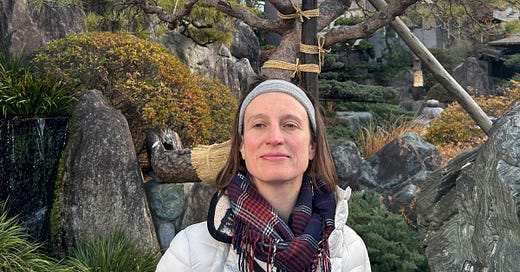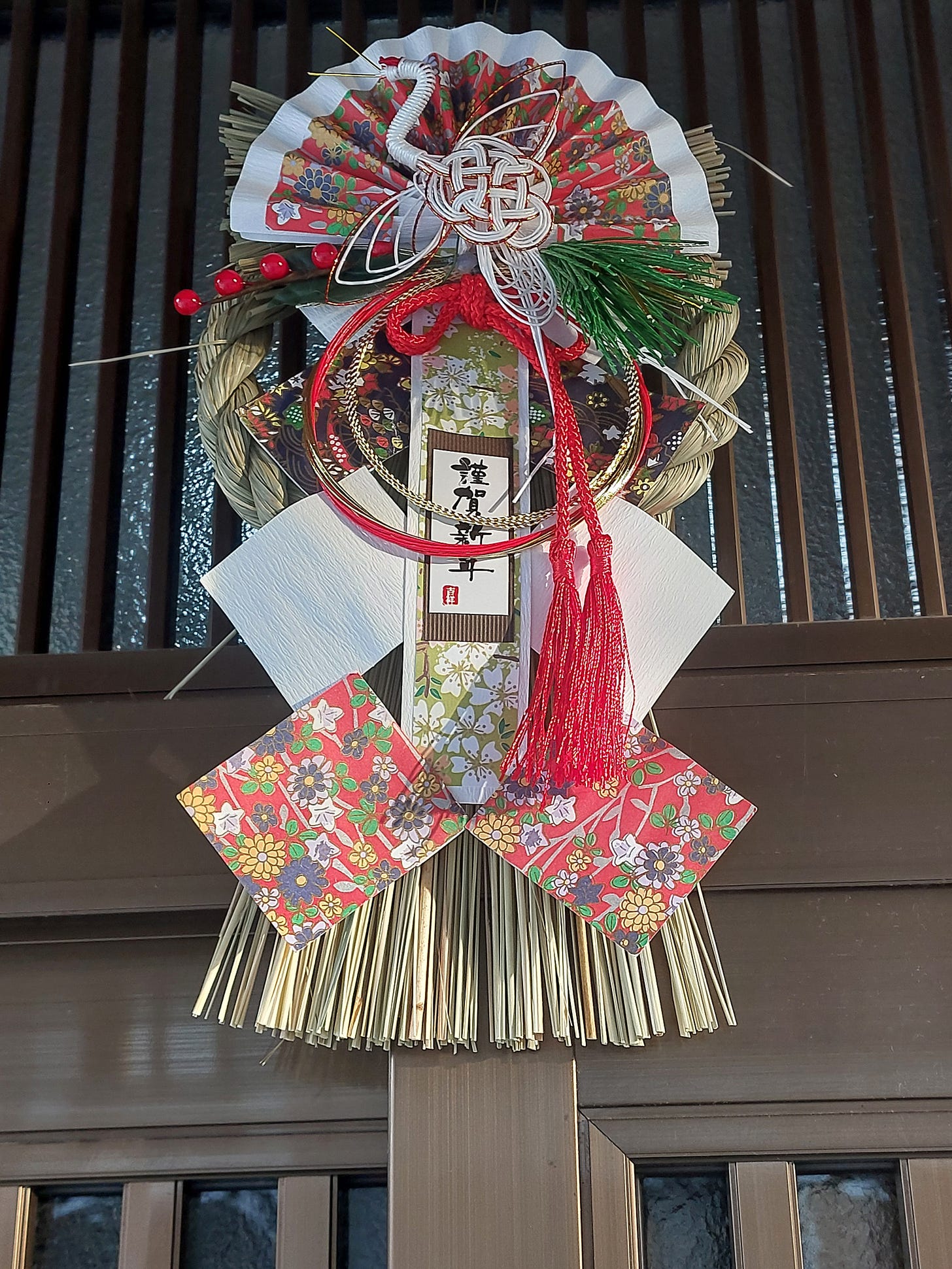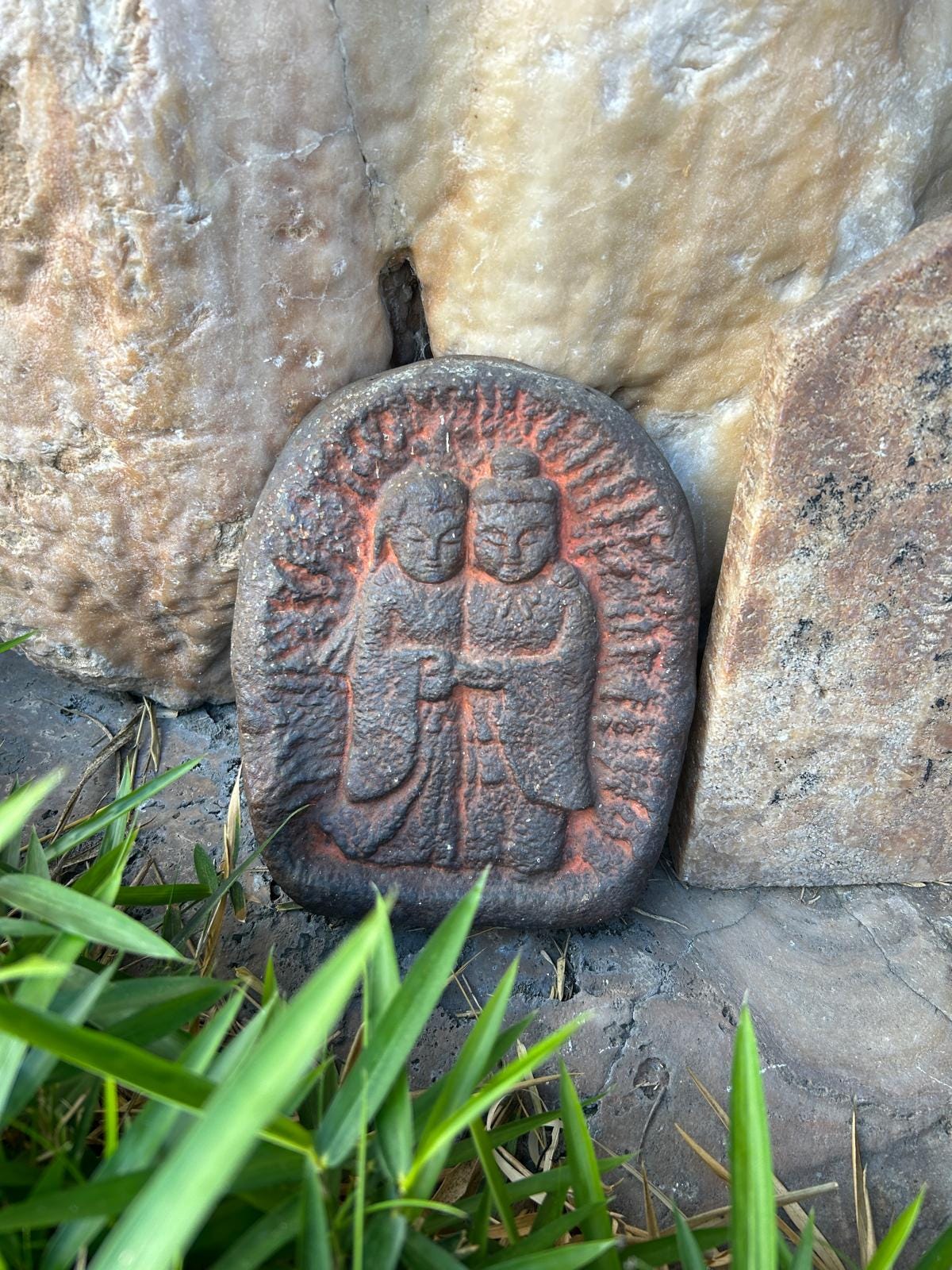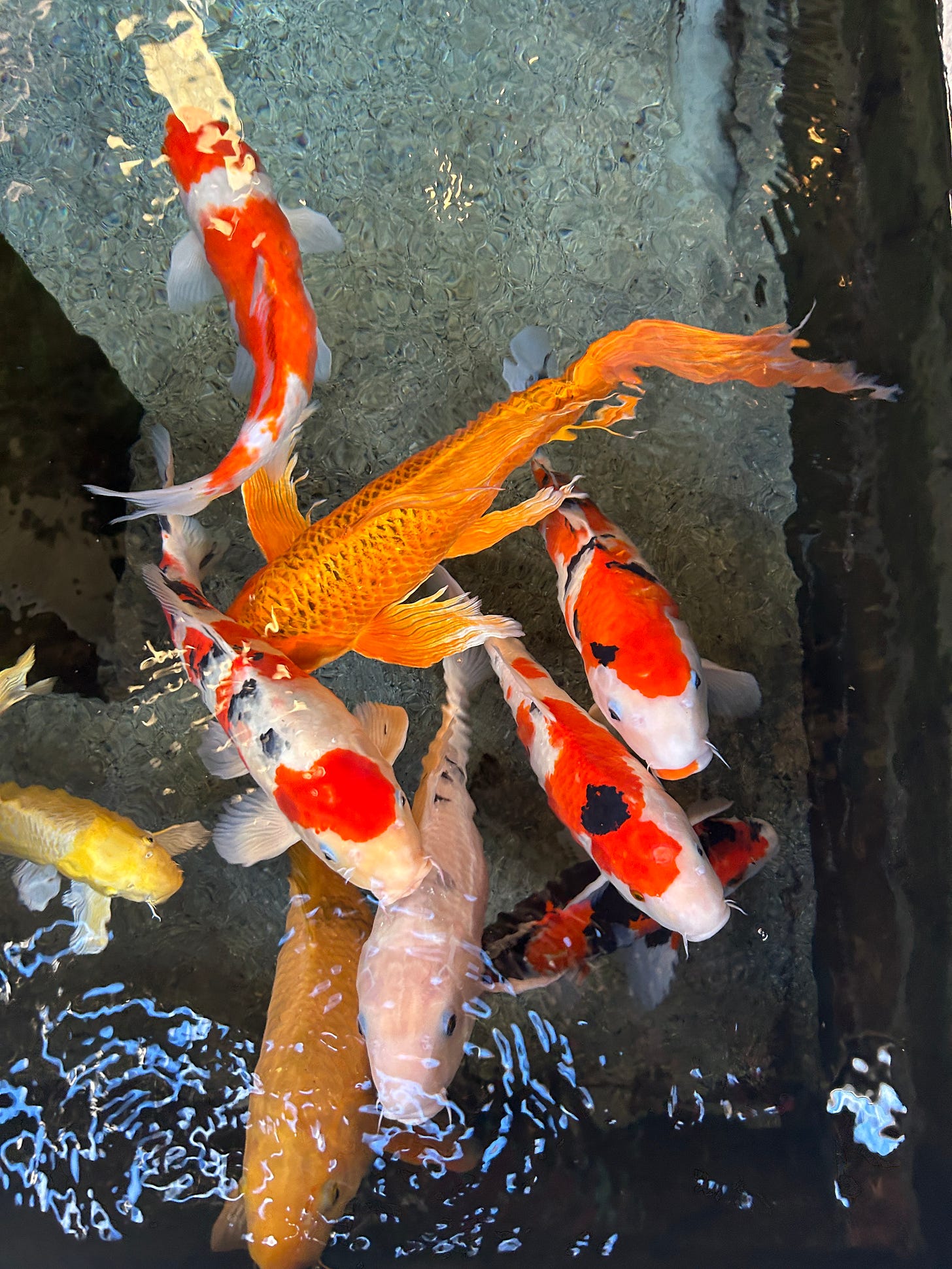Photo: David Horgan. Me looking incredibly relaxed in Onsen -town post-sauna.In the Japanese countryside I have become monk-like according to this photograph.
In Japan there is no central heating. In the city in December this is less shocking, there is the embodied energy of all the buildings plus our Air b n b host provides a space heater that we point at our feet and faces during the rare moments we sit down for a moment. (More on the Tokyo part of the travels here.) It is a different story in the countryside. We are now deep into the farmlands of the Yamanashi prefecture where my family live and the internal domestic climate is a chilly one. In a poorly insulated house - no disrespect to Japanese builders thin walls and rice-paper room dividers, plus a lack of explosive gas heating underground, is standard and sensible in a place of regular earthquakes- the feeling is a bit like camping. Like the late night or early morning part where you are just below comfortable temperature, where going to the toilet feels like a mission - the aim to minimise exposure - where you change your clothes as infrequently as possible - again exposure- and so begin to feel less fresh, the body tighter and stiffer. The main and communal room however is lit by a kerosene -heater which blast heats the room rapidly and emits fumes - again camping ambience - and so we spend most of our domestic time together in here drinking tea, eating dumplings and noodles, stretching. The glamping vibe is heightened at nighttime by the Japanese ‘beds’ - futons which are just three inches thin, this is probably healthier for the body in the long run, better than our too-thick, too-soft beds at home yet it's an adjustment. We begin to feel much like precious and coddled Westerners.
Photo: on the door of my family’s home, a New Year’s good luck decoration.
Beyond the house the air is warmer and mountain fresh. Something I did not know till now, and that I feel the Japanese tourism board could make more of, the winters here are bright and dry, the sky azure, it is chilly but far different from the slate-grey skies and general dismal, dank-ness of a European winter. The sun high in the sky raises the winter energy and mood.
Yamanashi is 360 mountains - ‘yama’ means mountain in Japanese. Some are thickly forested, others more bare and craggy, undulating and everywhere; we sit in a plateau surrounded. When I express something about the beauty of the mountains to my small niece as we travel about she says ‘this Japan’ and shrugs.
The low-lying plateau in which we sit is all farmland. Being late-December there is no fruit on the numerous trees that make up the landscape but instead bare twisted vines which by spring will be full of grapes - Yamanshi is famous as a wine-making area. There are more trees and at a distance I believe I see unseasonal white blossom perched on the angular limbs of an orchard full but as we approach we realise it is in fact white paper protecting the buds of future peaches. (Future peaches, I think, would make a perfect indie band name and the papered trees remind me of Yoko Ono’s Wish Tree art installation which we visited a decade prior in NYC.)
In Japan whole areas specialise in and improve certain produce with acute levels of commitment; the famous Japanese drive for perfection. Natives might drive for four hours just to eat a certain type of (plain) rice, to another prefecture to eat a particular type of perfect melon (or indeed strawberry, see said strawberry of dreams here), you can buy basic bimbo-style-bread in almost every store but you can also seek out a loaf that is a thing of beauty for the equivalent of twenty English pounds. A place of specialisms.
As well as fruit and wine the area is famous for the purity of its water, and most famous of all for being the home of Mount Fuji San.
My brother - who lives here - takes us in a winding, concentric drive, Mulholland-style, up and around the numerous mountain ranges. From many angles we see the iconic mount Fuji. Fuji san. The ‘san’ expressing reverence. There is a mountain-worshipping religious order here, they wear all white and devote themselves to hiking. Having climbed to the top of the mountain in August of 2016 and having wept at the mid-point of the climb - not from pain, (it’s an easy mountain to climb, Japanese children do it, as well as the elderly Japanese, the Japanese are fit!), but because of the sublimity of the view- perhaps the rarified air - I get it, I would join the order. We spiral up the road for a sunset view, dusky-pink light blurs the side of the mountain. Over the next week of our stay we see Fuji frequently - sometimes she wears a headpiece of white-clouds. Sometimes icy rivulets cover her whole crown. She is always a child's drawing of a mountain in her simplicity and classicism.
Fuji can only be climbed in the month of August (for the amateur climber anyway) and so on this visit we take a trek up a smaller mountain path to admire her (more clearly). My small niece is the leader and becomes incandescent if we overtake her at any point! At four she is going through an imperial phase, wearing a tiara and princess dress most of the time, including at times to bed, she also wishes to be hike-captain and general Queen of the family. She is adorable and I am content to be ruled by her. As we ascend it feels as if our lungs, full of winter bugs and used to the air of Brixton, are being washed by the mossy and pine-crisp air. At the zenith we sit on a wooden-bench to eat onigiri and drink coffee and to look once more at Fuji San bathed in the winter sun. As we descend something rapid, furry, ruddy-red in colour, and with odd pinion- like flaps scuttles across the path, ‘it’s got wings, Japanese foxes have wings!’ I shout. Everybody laughs at me. While I am wrong, Japanese foxes are not magical beings*, it turns out I what saw was just as wondrous, a flying squirrel which are endemic to the country. (I Google flying squirrels afterwards and apparently this sighting is a good omen for me - they are connected to feminine energy and balance, well thank you very much little furry friend!)
Another day we visit Isawa-Onsen which translates as Onsen town. Onsens are hot natural (geo-thermal) springs full of minerals and have been a big part of Japanese culture for thousands of years, the springs are considered healing and were (are?) used by the Emperor and his family, as well as civilians. The etiquette is naked, single-sex and no tattoos (owing to the Yakuza association of body-art). I do not want to be separated from David on our holiday to sit amongst unknown naked women, we also both have tattoos - I may be missing some great cultural experience but that is my overwhelming feeling (and it’s hard to change a feeling.) We manage instead to find an adjacent experience - saunas that have been built at an Onsen Hotel - Finnish style and private with an ice-plunge available. I read Tokyo Ueno Station by Yu Miri* while David ladles hot water and drips eucalyptus oil onto the coals. We plunge into the icy waters!
Photo: in the streets of Isawa-onsen I spot these two adorable Buddhas.
After the heat and ice our skin glows and we walk around Onsen town in a daze. It is the epitome of sleepy. I had expected it, being a cold month and the town an easy ninety- minutes from Tokyo, to be busier we see perhaps five people in the street, as always we find a convenience store*, the sauna has made us ravenous and there doesn’t seem to be anywhere to eat, we ask the convenience store workers for a restaurant recommendation and they draw two lines and a circle for us on their Seven-Eleven branded map. (***Side note: everywhere we go -in the city and in the countryside-there is a convenience store, Lawson, Seven-Eleven, and Daily-Mart are the most popular, spotting a Daily-Yamazaki with it’s primary red and yellow and superior bakery is a rare delight. As well as convenience stores, everywhere we go there are vending machines, including in very remote areas, there are often rows upon rows of them, typically offering hot and cold drinks, often including alcohol which does not require i.d. to purchase - something that strikes us as incredible - how this would be abused by British youths! But sometimes too with much more niche items such as woollen hats for cats, yakitori - skewered meat- in a can, and artisanal ice-cream.)
We pass more wooden buildings with Onsen signs, there are around fifty in the town, we spot numerous ponds with water features that host glimmering multi-coloured koi.
Photo: David Horgan koi ponds.
On another day we visit a local park which has a stream running through it, we pass to look over the bridge and see huge groups of muddy-brown fish swirling and gulping below us - it seems obvious now but we realise they have been bred to look so vivid and glamorous - they are really ‘just’ carp! (As well as carp this local park has amenities including a baseball pitch, enormous running track, and sports hall/gym complete with a sumo ring. It’s impressive but again we are amazed at the lack of people - a handful of families, some teenagers running a race, some kids on snake-boards. The feeling of a declining population is palpable outside of the cities.)
We follow our Seven-Eleven map to the Japanese version of a roadside diner, we are the only westerners and no one speaks English. We take off our shoes to sit at the sunken table, a huge wooden fish hangs over our heads, we slurp hot, yasai noodle soup as bosozoku boys buzz past noisily and everyone in the restaurant turns to look. An older Japanese woman rolls her eyes at them. They are little -gangsters- in -training, sixteen and seventeen -year olds on customised motorbikes some with pink paint jobs and streamers flowing, some with shiny chopper handlebars and enormous fairings. (Current estimates are that a third of bosozoku end up in the Japanese mafia, the yakuza).
Photo: Buddhist (and Shinto?) temple in Yamanashi.Look at that blue sky, picture taken December 31st!
At the end of the year we visit a beautiful temple, it is traditional on the first day of the new year to experience Hatsumode - a first shrine visit praying for a lucky year. We go one day early - on the 31st - there are a scattering of people: an older women sticking a bundle of stick-incense into an enormous copper bowl (a practice that honours passed loved ones), some twenty-somethings (one wearing all black, one wearing a bright orange furry jacket) who pose for photos with the incense, plus a couple who have paid to enter the depths of the temple - the woman stands in the centre of the space clapping skywards. Clapping in shrines is a signal of both respect and a way to wake the deities. It’s more associated with Shinto - the country’s indigenous religion which is nature-worshipping and pantheistic. (The temple seems to be a hybrid Buddhist - as a large statue testifies to - but with elements of Shinto.)
On one our of final evenings in Yamanashi my Japanese sister- in- law serves us a range of typical and unique Japanese dishes. The Japanese palate is developed differently, and much of this has translated hugely well - the western obsession with sushi, the embracing of umami, the status of Nobu. But one aspect of Japanese cuisine that I struggle to imagine ever becoming popular elsewhere is what my sister-in-law describes as 'slimy' food prized for its slippery texture which is considered very cleansing and which apparently holds health-giving properties. In Japanese the word for this food-group is ‘neba-neba’ which is certainly cuter than slimy, neba neba dishes are considered comforting, I guess in the same way that buttery toast is here. There are mushrooms drenched in an ectoplasm- like-substance, a bright-white radish that sprays as you bite into it, and of course the infamously stinky and sticky natto (fermented soya-beans).
On January 1st we take the train back to Tokyo, ready for our flight home the following day, a long-enough journey to drink a bottle of high-grade New Year’s sake between us. (It’s a tradition to drink on New Year’s day here, more than night). It is only a 90 minute trip but culturally and energy -wise the feeling is world’s apart.
*Recommended read: the novel is told from the outsider perspective of a Zainichi, Korean-Japanese narrator, and is an incredibly poignant read.
**Though maybe they are. Here is the Kitsune from the Yokai folkloric pantheon.
*** Recommended read: Convenience Store Woman by Sayaka Murata. Other recommended books can be found here.









This Japan ... how cute is this? Thank you for sharing your experience.
What an evocative piece of travel writing. Makes me want to visit! Have you seen this video of a flying squirrel faking its death? https://youtu.be/1CIMGTO6aFc?feature=shared&t=13